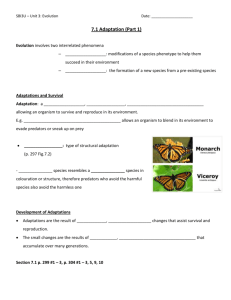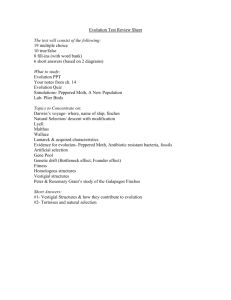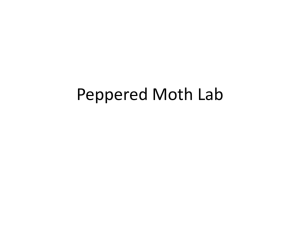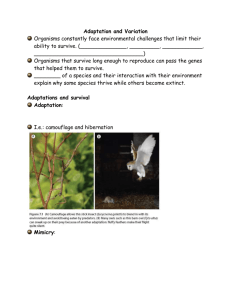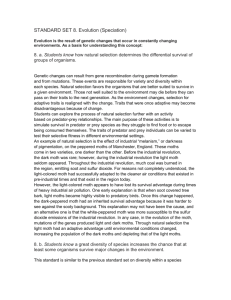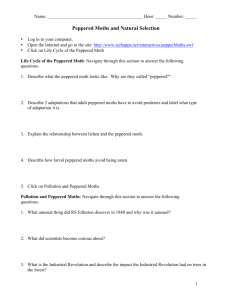SBI3U LAB: PEPPERED MOTH SIMULATION Objective
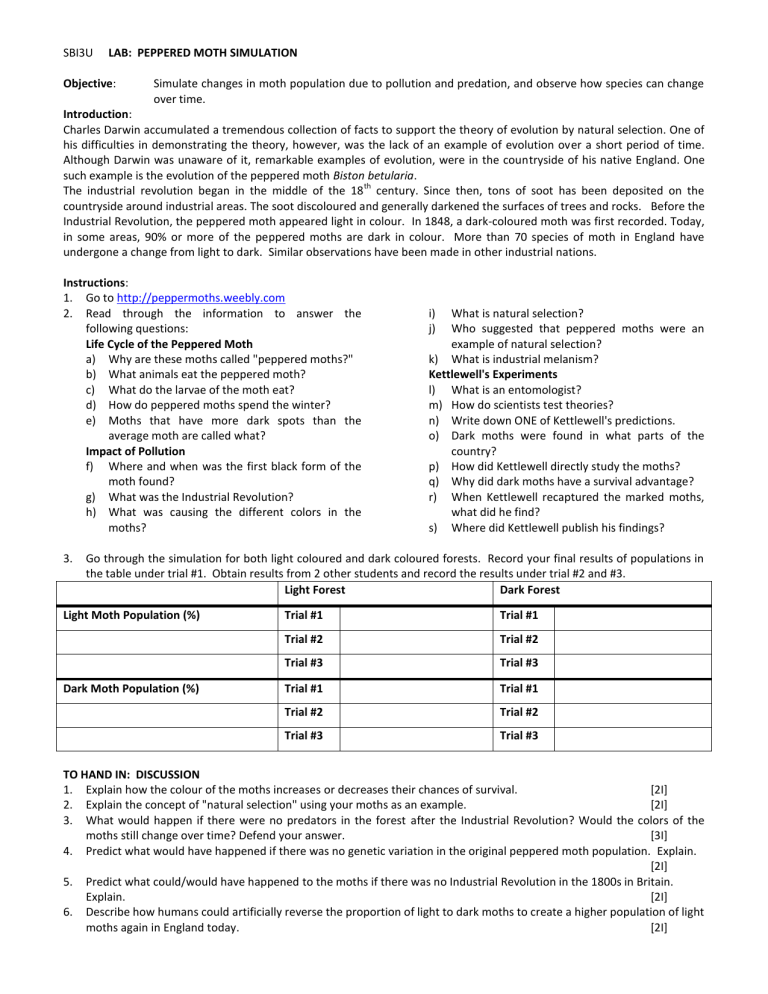
SBI3U LAB: PEPPERED MOTH SIMULATION
Objective : Simulate changes in moth population due to pollution and predation, and observe how species can change over time.
Introduction :
Charles Darwin accumulated a tremendous collection of facts to support the theory of evolution by natural selection. One of his difficulties in demonstrating the theory, however, was the lack of an example of evolution over a short period of time.
Although Darwin was unaware of it, remarkable examples of evolution, were in the countryside of his native England. One such example is the evolution of the peppered moth Biston betularia .
The industrial revolution began in the middle of the 18 th
century. Since then, tons of soot has been deposited on the countryside around industrial areas. The soot discoloured and generally darkened the surfaces of trees and rocks. Before the
Industrial Revolution, the peppered moth appeared light in colour. In 1848, a dark-coloured moth was first recorded. Today, in some areas, 90% or more of the peppered moths are dark in colour. More than 70 species of moth in England have undergone a change from light to dark. Similar observations have been made in other industrial nations.
Instructions :
1.
Go to http://peppermoths.weebly.com
2.
Read through the information to answer the i) What is natural selection? following questions:
Life Cycle of the Peppered Moth a) Why are these moths called "peppered moths?" b) What animals eat the peppered moth? c) What do the larvae of the moth eat? d) How do peppered moths spend the winter? e) Moths that have more dark spots than the average moth are called what?
Impact of Pollution j) k)
Who suggested that peppered moths were an example of natural selection?
What is industrial melanism?
Kettlewell's Experiments l) What is an entomologist? m) How do scientists test theories? n) Write down ONE of Kettlewell's predictions. o) Dark moths were found in what parts of the country? f) Where and when was the first black form of the moth found? g) What was the Industrial Revolution? h) What was causing the different colors in the p) How did Kettlewell directly study the moths? q) Why did dark moths have a survival advantage? r) When Kettlewell recaptured the marked moths, what did he find? moths? s) Where did Kettlewell publish his findings?
3.
Go through the simulation for both light coloured and dark coloured forests. Record your final results of populations in the table under trial #1. Obtain results from 2 other students and record the results under trial #2 and #3.
Light Forest Dark Forest
Light Moth Population (%) Trial #1
Trial #2
Trial #3
Trial #1
Trial #2
Trial #3
Dark Moth Population (%) Trial #1
Trial #2
Trial #3
Trial #1
Trial #2
Trial #3
TO HAND IN: DISCUSSION
1.
Explain how the colour of the moths increases or decreases their chances of survival.
2.
Explain the concept of "natural selection" using your moths as an example.
[2I]
[2I]
3.
What would happen if there were no predators in the forest after the Industrial Revolution? Would the colors of the moths still change over time? Defend your answer. [3I]
4.
Predict what would have happened if there was no genetic variation in the original peppered moth population. Explain.
[2I]
5.
Predict what could/would have happened to the moths if there was no Industrial Revolution in the 1800s in Britain.
Explain. [2I]
6.
Describe how humans could artificially reverse the proportion of light to dark moths to create a higher population of light moths again in England today. [2I]



